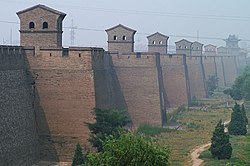
A whirlwind of events occurred, culminating in me going to China alone to compete in the First International Invitational Xingyiquan Competition and 20th Annual San Shou Tournament. The Competition was to be held in Pingyao, Shanxi Province China, an ancient historical city. According to Wikipedia:
Historical importance
Pingyao still retains its city layout from the Ming and Qing dynasties, conforming to a typical bagua pattern. More than 300 sites in or near the city have ancient ruins. Preserved Ming- and Qing-style residences number close to 4,000. The streets and storefronts still largely retain their historical appearance.
In the Spring and Autumn Period, the county belonged to the kingdom of Jin. It was part of the kingdom of Zhao in the Warring States Period. In the Qin Dynasty, it was known as Pingtao. During the Han Dynasty, it was known as Zhongdu county. In 1986, the People's Republic of China designated Pingyao as one of the Chinese Historic and Cultural Cities. It became a World Heritage Site in 1997, included also the outlying Zhenguo Temple and Shuanglin Temple.
City walls
The city walls of Pingyao were constructed in the 3rd year of the Hongwu Emperor (1370). The walls have six barbican gates. The north and south sides have one gate each. The east and west sides have two gates each. This pattern is similar to that of a turtle (the head, tail, and four legs), earning Pingyao the moniker "Turtle City." The walls measure about 12 meters high, with a perimeter of 6,000 meters. A 4-meter wide, 4-meter deep moat can be found just outside the walls. Aside from the four structured towers at the four corners, there are also 72 watchtowers and more than 3,000 battlements. In 2004, part of the southern walls collapsed but were reconstructed. However, the rest of the city walls are still largely intact and are considered among the best-preserved ancient city walls on this scale. This makes the city walls the centerpiece of the Heritage Site.
At this point I had mostly learned traditional Shaolin martial arts from Mr. Chen, as it was his specialty (the main styles of Ba Fan Shou and Mian Zhang Quan were local styles of Shanxi Province). I had only learned the wuxing or Five Shapes, Jin Tui Liang Huan Quan (Front Back Step Continuous Form) and Ji Xing Si Ba (Chicken Four Hand Grabbing), and Wu Hwa Pao (Eight Flower Cannon) styles of Xingyiquan. I had not yet learned the famous Twelve Animal Styles of Xingyiquan. Frankly, I was very scared to go to China and demonstrate my xingyiquan in the home province where the art originated; and on an international stage! What had I gotten myself into, and why did I agree to do this? Such were the thoughts that went through my head, when I had any time to think.
But I didn't have much time to think about it because there were applications to fill out, passports and visas to apply for, and arrangements to be made. Who would take care of my dogs while I was away for a month? What about the job I had, could I get the time off and still have a job upon my return? All of these things had to be figured out quickly because the competition was only a few months away. Mr. Chen seemed to recovery quickly, and was soon watching me like a hawk, just like in the old days. His living situation had changed again, and he and his wife were now living in the Tomac Motor Lodge on Rt. 10 in Morris Plains, NJ. Most of my training took place in that motel room, with Mr. Chen still recuperating in bed. With great effort, he would rise from the bed to correct a few of my movements before almost collapsing back into the bed out of exhaustian. That was when I realized and understood the master's lifelong love for traditional Chinese Martial Arts. I remembered a story his daughter Jinling had once told me:
When the young Chen Jun Hao was learning traditional martial arts, China was undergoing the Cultural Revolution. During that time, all things traditional, intellectual or artistic were basically banned by Chairman Mao Zedong's Communist Party. People who were caught practicing these things would be punished severely--beaten and possibly even killed. Their entire family would suffer greatly as a result. Mr. Chen was in possession of some very extensive "martial arts manuals"--the kind of comprehensive, hand-written and illustrated manuals that contained the lineage secrets of his traditional martial arts. Mr. Chen's father was very frightened that the Red Guard might search and find these manuals, so he burned them. According to Mr. Chen's daughter, those manuals contained the jewels of Chinese traditional martial arts culture--pure national treasures burned to ashes in the 1960's by Mr. Chen's own father.
Mr. Chen risked everything to learn these arts, and decades later he was teaching them in America, to me. "Many people in Taiyuan know who I am, and they will know that you are my student. If you make a poor showing at the competition, it will make me look bad." That's exactly what he said to me one day when I was struggling through the forms. For the next couple of months, I ate, drank, slept, dreamt and lived xingyiquan. I forgot about my fear of going to China and looking like an American clown. Soon Mr. Chen starting saying "no" less and "okay!" more often during my training. I reached the place where I got as good as I possibly could at that moment in time, and there was nothing left but to board the plane for China.
Next: China, August 2001


2 comments:
no pressure - but
"If you make a poor showing at the competition, it will make me look bad."
I know,he was so blunt....
Post a Comment